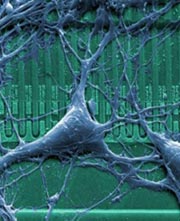Researchers at the University of Padua in Italy have developed “neuro-chips” in which living brain cells and silicon circuits are coupled together.
The scientists squeezed more than 16,000 electronic transistors and hundreds of capacitors onto a silicon chip just 1 millimeter square in size. They used proteins found in the brain to glue neurons onto the chip. The proteins acted as more than just a simple adhesive.

The proteins allowed the neuro-chip’s electronic components and its living cells to communicate with each other. Electrical signals from neurons were recorded using the chip’s transistors, while the chip’s capacitors were used to stimulate the neurons.
It could still be decades before the technology is advanced enough to treat neurological disorders or create living computers, but in the nearer term, the chips could provide an advanced method of screening drugs for the pharmaceutical industry.
“Pharmaceutical companies could use the chip to test the effect of drugs on neurons, to quickly discover promising avenues of research,” explained Stefano Vassanelli.
The researchers are now working on ways to avoid damaging the neurons during stimulation. The team is also exploring the possibility of using a neuron’s genetic instructions to control the neuro-chip.
Thanks Beverly!
Via LiveScience, IST. Image.







